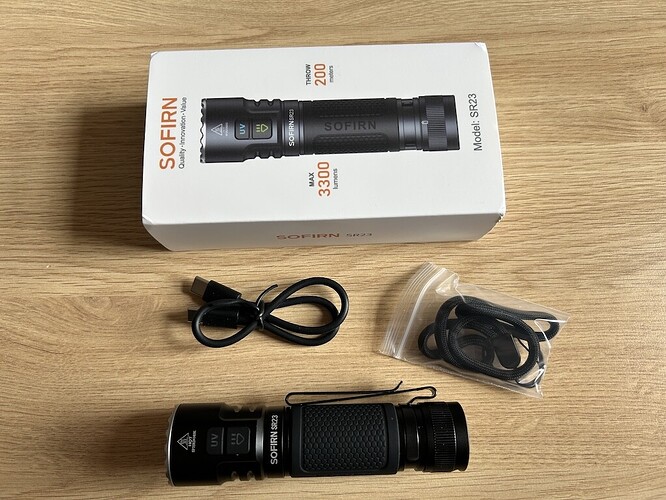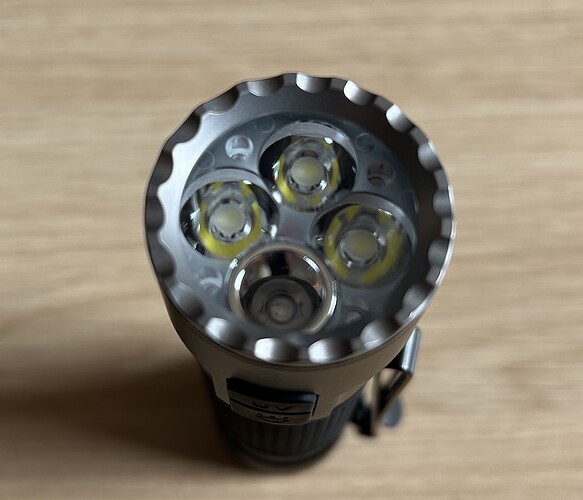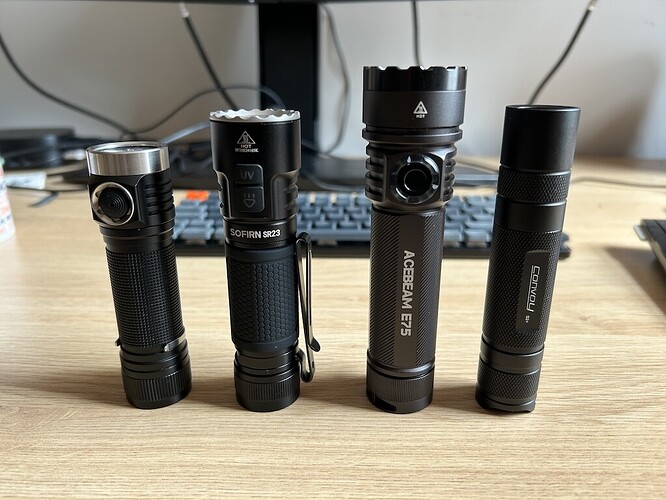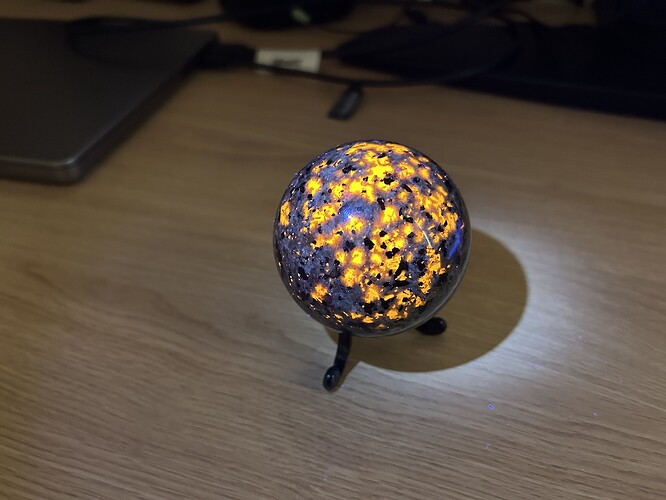Pricing and availability
Sofirn kindly sent me this light to review. It’s currently on their website for £30.26 or $40.99 thanks to a 30% off offer. (£43.23 / $58.55 normally)
This will be an honest review, any flaws or dislikes will be mentioned.
What comes in the box?
The box is a nice retail package consisting of a coloured slip-cover over a white card-stock box with magnetic closure. The light itself sits nestled in foam for protection. Inside we find:
• The light itself.
• Dual direction, deep-carry pocket clip. (Attached)
• Sofirn-branded 21700 flat-top battery. (Inside the light)
• A 31 cm USB-C to USB-C charging cable.
• A small bag containing a lanyard and two spare O-rings.
• Printed manual.
Emitters
This is a quad emitter light with three TN-3535 cool white emitters and one 365 nm UV emitter. The white emitters are stated to be 6500 – 7000 K. I only have an app on my phone to measure this, but I got 5500 – 5700K with a duv of +0.019. Using the same app to test other lights with 519a emitters yielded results around what I would expect for the emitter, so as far as I can tell it’s reasonably accurate. YMMV. Nevertheless, the result is that the light is warmer than stated but still cool and very green. I can’t measure CRI, but it’s low. Cool white is what the masses want and it is good for efficiency and output, but personally I would have preferred warmer and ideally high CRI emitters for the white channel.
Design and build quality
The white emitters have TIR optics and the UV emitter has a small reflector, and the entire thing is then covered by a glass lens. There is no ZWB filter for the UV emitter.
For further protection the lens is recessed 3 mm below a lightly crenulated bezel which has a nice bead-blasted finish. Sofirn describe the bezel as stainless steel and I have no reason to doubt them. The crenulations are nicely done, they don’t feel sharp and I like the contrasting finish. The pocket clip is friction fit, alllows deep-carry and feels reasonably sturdy. The clip is double-ended but I imagine the light’s a bit big to clip onto a hat brim. There is a lanyard hole in the clip, but the one on the tail-cap would be a better option, this hole is nicely off-set so that adding a lanyard will still allow the light to tail-stand, which it does very nicely. The tail-cap is magnetic and will hold the light to a vertical surface nicely. I could not see a way to remove the magnet. Threads are anodised allowing mechanical lock-out. The anodising is satin black and nicely done, with crisp white lettering. Overall, the quality of the light is very nice indeed. I do wonder how well the rubber grip will hold up over time, it’s an unusual feature in a light and personally I think I would have preferred knurling. The cover for the USB port is thick and stays in place nicely.
Size and comparisons
Left to right – Emisar D4K, Sofirn SR23, Acebeam E75, Convoy S2+.
For a 21700 light this is pretty compact, it is slightly bigger than the D4K but it offers on-board charging which the D4K does not. It is comfortable to hold and generally just feels to be a nice size although it is on the larger side for an EDC light.
Length – 116 mm
Body – 27 mm
Head – 31.5 mm
Weight – 161 g with battery, 92 g without
Batteries and charging
Sofirn include one of their branded 5000mAh 21700 batteries, this is a flat-top and appears to be unprotected. Thanks to this and the light having springs at both ends, it happily accepted one of my own Molicel flat-tops.
Charging is via USB-C, using the included cable it started charging at 1.9 A, around 45 minutes later this had dropped to 0.9 A, dropping further as the charge went on. The button for the white light lights up red while charging. After 1 hour and 40 minutes the indicator light went green and charging stopped, I measured the battery at 4.18 v.
UI and switches
Each channel has its own switch, I like this as it makes the light very intuitive to use. The buttons are illuminated, the one for the UV channel stays lit as long as the UV emitter is on. The one for the white channel illuminates for 5 seconds at turn-on to display the battery level as below:
Green solid = 75% - 100%
Green flashing = 50% - 75%
Red solid = 25% - 50%
Red flashing = 1% – 25%
I love this. Battery check is a feature I value in my lights and that a lot of manufacturers fail to implement well.
UV channel – This is simplicity itself, click for on / off and hold to cycle between two brightness levels.
White channel:
This uses the familiar e-switch shortcuts -
From off:
1H = low (needs second press to ramp up from low)
1C = on (memorised level)
2C = turbo
3C = strobe
From on:
1C = off.
1H = ramp up brightness. (Within 1.5 seconds 1H again will ramp down)
2C = turbo (1C to return to previous level)
3C = strobe
Levels accessed via shortcut, ie low and turbo are not memorised.
I really like that 1H from off gives you the lowest mode and it does not ramp up unless you release the switch and press it again. This may be subjective, but if I want the lowest mode I want the lowest mode, having the light stay at floor level makes this easy. I have no way to measure the output but by eye it is slightly brighter than firefly 3 on my Wizard which is a stated 5.6 lumens, in my opinion it’s too bright to be considered moonlight.
There is no option for stepped levels, ramping only, and it does ramp rather quickly making fine adjustments at low levels somewhat finicky. You can get it slightly brighter than the floor level but you have to be quick and it’s easy to over-shoot.
It could just be my example, but adjusting the brightness is… unpredictable. If the light is turned on at a level part-way up the ramp sometimes it will ramp down instead of up. Alternatively, if the memorised level is brighter than desired and you ramp it down, when you attempt to turn the light off you sometimes get turbo instead. Or strobe. Or off. There’s really no way to tell until you hit the switch and see what happens. I’m going to assume that this is a fault.
Beamshots
The UV works! (Yooperlite ball)
Outdoors
Please note that I only have the camera on my iPhone and it has no way to manually set the white balance. As a result the colour in the photo looks better than it does in real life.
There is a bridge at the 90 m mark but I couldn’t really see it, the beam is floody so trying to get distance with brute force makes the foreground too bright to see much beyond. It does put out a ton of light on the highest setting though, and the smooth and artefact-free beam would make it well suited as a walking light.
Conclusion
There is a lot to like here, the build quality is good and the UI is well thought-out and intuitive. I would prefer steps rather than a ramp, but this is subjective and I know many people prefer ramping. The weird behaviour is probably unique to my light, but I did on several occasions get turbo or strobe instead of off.
The UV light is pretty powerful and seems to have a narrow-ish beam so you can glow stuff from a few metres away which could be useful for searching for glowing rocks or scorpions if they happen to live near you. Having a dedicated button for this makes it easy to use.
In my opinion the emitter choice for the white light lets it down overall, offering Nichia 519a emitters would be a huge improvement and with a 21700 battery the reduced efficiency would not be a concern. My iPhone insisting on fixing the white balance is painting the emitters to be much nicer than they are, I don’t mind the CCT but they are green at all levels. That said, they do put out a ton of light with a nice beam.
I liked:
- Form factor
- UI
- Dual buttons
- Build quality
- Beam shape and smoothness
- Battery level indicator
I did not like:
- UI quirks with random turbo / strobe (likely unique to my light)
- Green tint




